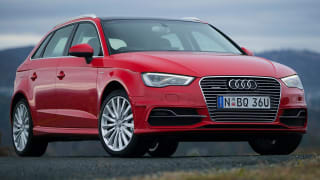
Audi A3 Sportback e-tron 2015 review
Chris Riley road tests and reviews the Audi A3 Sportback e-tron plug-in hybrid, with specs, fuel consumption and verdict at its Australian launch.
Browse over 9,000 car reviews
Edgy and futuristic, the new Prius is no match for its stablemate, the Camry Hybrid.
There are lots of reasons why you and I should like the latest Toyota Prius.
A total rethink, rework and revamp of the petrol-electric champion brings all sorts of benefits, especially for fans of hybrid driving. And there is lots of extra bling, including an inductive charging system in the bright white centre console that means you don’t have to plug your phone — currently only Samsung is compatible — into a socket for a boost.
Toyota says the 1.8-litre petrol engine now operates at 40 per cent of thermal efficiency, which is impressive for anything with petrol power, while the various hybrid bits and pieces are smaller, lighter and more efficient.
I’ve yet to hear of a private Prius owner who has needed a battery replacement, with stories of taxis that have run for more than 350,000 kilometres without problems, but the battery in the car is now tucked under the back seat to give a worthwhile boost in boot space, to a healthy 502 litres.
A redesign of the double-wishbone rear suspension also liberates more boot space and smooths the rear-end ride while improving grip.
Other things I like are the excellent heads-up display, which beats everyone including BMW for clarity, and the giant multimedia screen.
Toyota says it has sold 50,000 hybrids in Australia.
The Prius has not been tested for an ANCAP safety rating, but there is an impressive battery of active and passive systems including active cruise control, lane-departure alert and auto high beam, while the i-Tech I’m driving also gets blind-spot monitoring and a rear cross-traffic alert in addition to the rear-view camera.
But I have three questions. Are people really convinced about hybrid cars? What do they think of the bodywork on the Prius? How does the Prius line up against the Camry Hybrid, especially when the bigger, locally-made car is available from $26,990 drive-away and the base price for the import is $34,990?
On the first front, Toyota says it has sold 50,000 hybrids in Australia. But only 18,000 are Prius, a number that’s topped by the Camry, and that’s over three generations since the first one landed in 2001.
On the price line, the Camry is a clear winner. It also has a bigger cabin and is a much nicer drive, particularly on bumpy or grotty country roads.
And the styling? I’m no judge of beauty, but several friends aren’t at all taken by the new look. The design seems extreme and edgy for the sake of it, like the overdone design work in Japanese manga cartoons.
I’m spending my drive time in a fully-loaded Prius i-Tech with silver pearl paintwork, which takes the price to $43,440. That’s an ouch for me, but I like the leather seats and the sunroof and the sound system is good.
The boot is finally roomy and useful, the cabin is comfy and pretty roomy for the size of the body, and the car is very quiet on good roads. I love the silent electric takeoff, which still impresses people, and the transition to petrol power is as seamless as always.
The front suspension crashes through bumps, the body wobbles around over bitumen acne.
Toyota does not give a 0-100km/h sprint time but the Prius is quite lively, with good overtaking pace. Not surprisingly, for a car focused far more on its 3.4 litres/100km consumption claim, there are no flappy paddles for keener drivers.
Apart from the looks, which seem more extreme every time I walk back to the Prius, my big disappointment is the chassis. The front suspension crashes through bumps, the body wobbles around over bitumen acne, and it’s surprisingly noisy with more tyre roar than I like. Some of the noise is probably accentuated by the quietness of the engine, but it’s not as quiet as I’d like.
The Prius makes the most sense on stop-start city runs (hence their popularity with taxi and hire car drivers) but on long distances in the outback they are still a petrol car in most conditions. In that case, cheaper diesel alternatives do a better job.
I have other reservations, too. The Prius needs servicing every six months, even if the cost of the work is pegged at $140 a visit. It also only has a space-saver spare, which is pared back to an inflation kit in the i-Tech model.
I keep coming back to the petrol-electric Camry, which beats it on price, comfort, space and impressive driving manners.
$29,800 - $31,888
Based on 3 car listings in the last 6 months
So, yes, the new Prius looks suitably edgy and futuristic — a lot like the hydrogen-powered Mirai that’s just joining the Toyota family — and I like the toys and trinkets. But I still cannot recommend it.
So there is no Tick for the Prius but for Toyota and hybrid fans, the Camry Hybrid definitely qualifies for one.
$29,800 - $31,888
Based on 3 car listings in the last 6 months